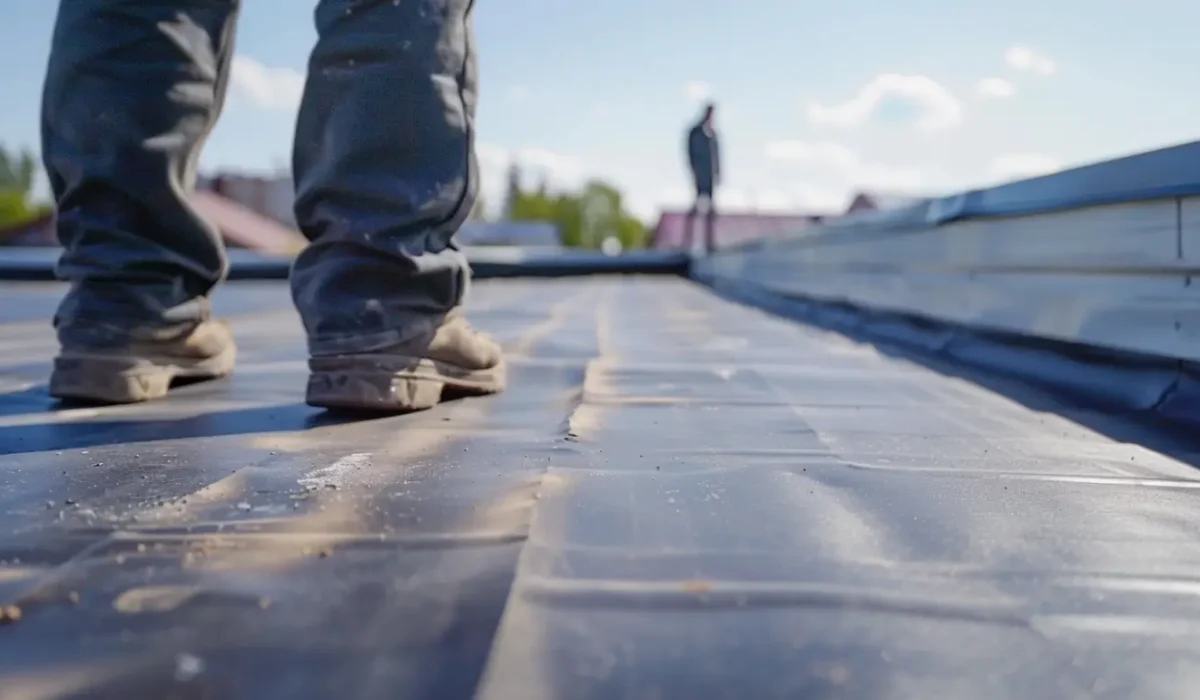Understanding the lifecycle of a commercial roof is essential for property managers and business owners alike. At KangaRoof, we emphasize the importance of selecting roofing materials tailored to the specific needs of each building in Coppell, TX. Throughout its life, our team provides regular inspections and ongoing maintenance, which play pivotal roles in maximizing the roof’s lifespan, preventing costly repairs, and ensuring energy efficiency. Finally, recognizing when a roof reaches the end of its functional life is crucial for planning the replacement project, and our experts are here to assist in safeguarding your business operations.
Key Stages in the Lifecycle of a Commercial Roof
Understanding the key stages is essential for optimizing the performance and longevity of a commercial roof. The initial planning and installation phase sets the foundation, where quality of installation and choice of materials greatly impact the roof’s lifespan. Following this, the early performance and settling period involves monitoring for potential issues and ensuring proper drainage systems are in place. Preventive maintenance and regular inspections form the backbone of ongoing maintenance, allowing property managers to identify signs of damage early on and make informed decisions regarding repairs or replacements.
Contact Us

Initial Planning and Installation
A successful commercial roofing project begins with meticulous initial planning and installation. Engaging qualified roofing contractors ensures the right roofing materials are selected, tailored to the specific needs of the commercial building. During this phase, considerations such as the installation process, safety measures, and obtaining necessary permits are crucial. The quality of installation has a direct influence on the roof’s lifespan, as it lays the foundation for future performance, ultimately impacting maintenance costs and the long-term viability of the roofing system.
Early Performance and Settling Period
Early on, a new commercial roof exhibits its performance characteristics, influenced by the quality of installation and roofing materials used. During this settling period, it’s crucial to monitor the condition of your roof and address any potential issues that arise, such as minor leaks or drainage challenges. Regular inspections by qualified roofing contractors help ensure that the roofing system remains functional and efficient. Proper attention during this phase can prevent costly repairs and prolong the roof’s lifespan significantly.
Preventive Maintenance and Regular Inspections
Implementing a structured preventive maintenance plan minimizes the risk of costly repairs and extends the life of your roof. Regular inspections conducted by qualified roofing contractors help identify potential issues early, such as persistent leaks or damage from UV rays and foot traffic. These assessments ensure that the underlying structure remains intact and functional. By addressing minor repairs promptly, property owners can maintain energy efficiency and safeguard their commercial building against unexpected failures, leading to informed decisions regarding long-term upkeep.

Factors That Influence Commercial Roof Lifespan
Several key factors influence the lifespan of a commercial roof, beginning with the choice of roofing materials. Options like TPO and modified bitumen each offer different durability and performance characteristics, affecting long-term viability. Additionally, the quality of installation plays a critical role; employing a qualified roofing contractor ensures adherence to industry best practices, reducing the risk of premature replacement. Regular inspections and ongoing maintenance also contribute significantly, identifying potential issues early and enhancing energy efficiency for the building’s overall performance.
Choice of Roofing Materials (TPO, Modified Bitumen, etc.)
Selecting the right roofing materials is crucial for maximizing durability and energy efficiency. Tthermoplastic olefin (TPO) is popular choices, known for their resilience against UV rays and weather conditions. Modified bitumen provides added strength, making it suitable for areas with heavy foot traffic. Each option plays a significant role in your commercial roofing system’s performance, influencing maintenance costs, lifespan, and the overall success of your roof replacement project. Engaging a qualified roofing contractor ensures you choose materials tailored to your specific needs.
Quality of Installation and Contractor Credentials
A successful roofing project hinges significantly on the quality of installation and the credentials of the contractor. Engaging qualified roofing contractors ensures adherence to industry standards, which is crucial for maximizing the lifespan of your roofing system. These professionals are equipped to handle specific materials like TPO effectively, minimizing the risk of premature replacement. Conducting thorough inspections of a contractor’s previous work and understanding their warranty policies can provide insights into their reliability and the quality of installation, setting the foundation for long-term performance.
Climate, Weather, and Environmental Stressors
Variations in climate and weather significantly impact the performance and longevity of a commercial roof. Prolonged exposure to UV rays, heavy snowfall, or intense storms can lead to accelerated wear and tear, necessitating prompt repairs and vigilant maintenance. Additionally, environmental stressors like fluctuating temperatures and humidity levels may contribute to the aging of roofing materials. Property managers must regularly assess the roof’s condition and consult with qualified roofing contractors to ensure adequate protective measures are in place, safeguarding the investment in the roofing system.

Typical Lifespan Expectations for Different Commercial Roof Types
Understanding the longevity of various commercial roofing systems is essential for property managers and business owners planning for future maintenance and replacement needs. Flat roofs, such as those made from TPO or EPDM, typically have an average lifespan of 15 to 25 years, depending on installation quality and ongoing maintenance. In contrast, pitched roof systems generally last longer, ranging from 20 to 50 years, thanks to superior drainage and reduced exposure to UV rays. Choosing the right roofing materials can significantly impact these expectations.
Flat Roofs vs. Pitched Roof Systems
Comparing flat roofs and pitched roof systems reveals key distinctions in their design and performance. Flat roofs, often favored for commercial properties, provide easier access for maintenance tasks and equipment installation, yet they require careful attention to drainage systems to prevent water accumulation. On the other hand, pitched roofs offer superior durability against harsh weather conditions and prolonged lifespan due to effective water runoff. Both options necessitate quality installation and regular inspections, ensuring they meet business operations’ demands while optimizing the roof’s lifespan.
Impact of Brand Selection: Malarkey, GAF, OC
Choosing the right brand for a commercial roofing system significantly impacts the roof’s lifespan and performance. Companies like Malarkey, GAF, and OC offer distinctive advantages, including advanced technology and innovative materials, which enhance energy efficiency and weather resistance. Collaborating with qualified roofing contractors ensures that these high-quality materials are installed correctly, addressing current conditions and potential issues. This informed decision ultimately influences maintenance costs and the durability of the roof, making it essential for property owners to consider brand reputation and expertise during the selection process.

Visible Signs Your Commercial Roof Needs Attention or Replacement
A commercial roof may show various visible signs indicating it requires attention or replacement. Look for persistent leaks, water stains on ceilings, and curled or missing shingles, as these can signal underlying issues. Additionally, increased energy costs may suggest insulation problems or inefficient roofing materials. Regular inspections by qualified commercial roofing contractors help identify potential damage early, ensuring that appropriate maintenance is conducted. Prompt repairs and proactive management can significantly extend the life of your roof and prevent costly replacements.
Common Damage and Wear Indicators
Unexpected issues can arise in the life of a commercial roof, necessitating vigilant observation by property managers and business owners. Common indicators of damage include persistent leaks, which may indicate serious underlying problems affecting the roof’s lifespan. Additionally, UV rays can deteriorate roofing materials, leading to cracks and premature replacement. Regular inspections reveal the current condition of your roof, while identifying wear caused by foot traffic or storm damage can help mitigate costly repairs and extend the overall durability of your roofing system.
Increased Energy Costs and Interior Leaks
Rising energy expenses often indicate underlying issues within a commercial roofing system. Inefficiencies in insulation or damage to the roofing materials may lead to excessive heat loss or gain, compelling HVAC systems to work overtime. This can translate to inflated utility bills. Moreover, persistent leaks due to compromised seals or wear can create interior water damage, endangering the structure and necessitating prompt repairs. Regular inspections will help identify these concerns early, ensuring the longevity and safety of the roof while minimizing maintenance costs.
Get in Touch
A well-maintained commercial roof can significantly enhance the longevity and efficiency of a building. Engaging qualified roofing contractors, especially those with certifications such as OC Preferred, Emerald Premium Plus, and GAF Master Elite, ensures that proper installation and ongoing maintenance are prioritized. By making informed decisions regarding roofing materials and scheduling regular inspections, property owners can mitigate potential issues and avoid costly repairs. Ultimately, investing in a new roofing system or timely replacement aligns with best practices, safeguarding business operations and comfort while optimizing energy efficiency throughout its lifecycle.
Frequently Asked Questions
What happens during a commercial roof replacement process?
During a commercial roof replacement process, the old roof is removed, structural assessments are made, and necessary repairs are conducted. New materials are then installed according to specifications, followed by thorough inspections to ensure proper installation and functionality before final approval for use.
What is the lifespan of a commercial roof?
The lifespan of a commercial roof varies by type, material, and environmental factors. Typically, roofs can last from 15 to 50 years, depending on maintenance practices and the roofing system chosen. Proper care and timely repairs can significantly extend this lifespan.
Read our blog: Essential Roof Safety Tips for DIY Maintenance
